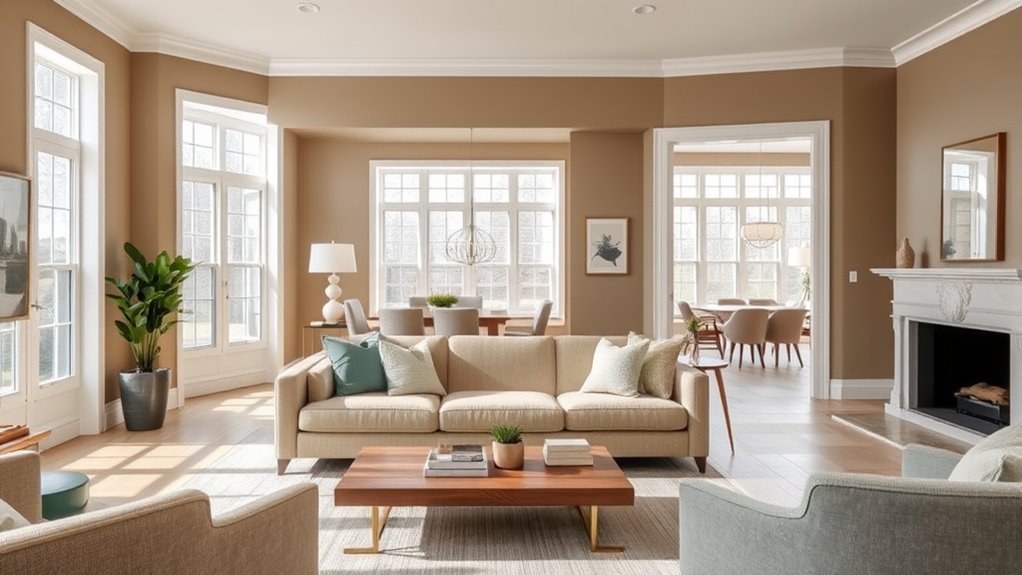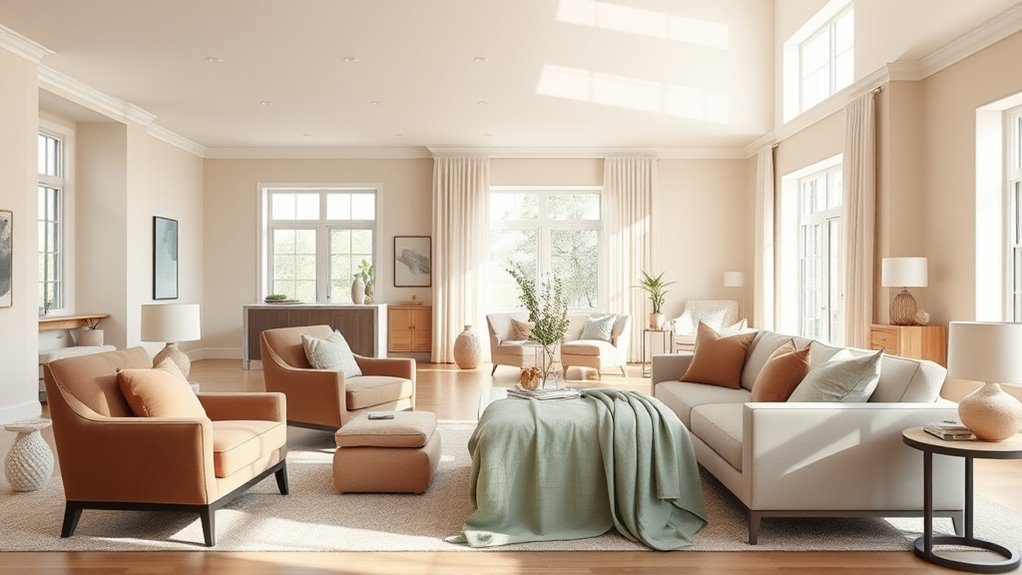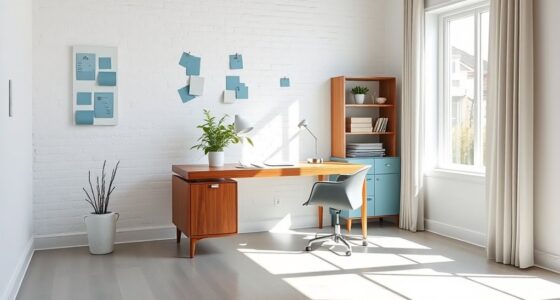To choose a whole-home color palette, start by exploring colors that evoke the mood you want in your space, using color psychology as a guide. Select versatile shades that can flow around your home with subtle variations, like neutrals combined with accent colors. Consider how lighting affects these hues and choose finishes that suit each area. If you keep these tips in mind, you’ll craft a harmonious and personalized environment that feels cohesive throughout.
Key Takeaways
- Select a versatile base color palette with neutral tones like taupe or greige for cohesion.
- Incorporate subtle variations and complementary shades to create visual interest and flow.
- Use color psychology to evoke desired emotions, choosing calming or energizing hues appropriately.
- Test paint samples in different lighting conditions to ensure consistent appearance throughout the home.
- Consider the finishes and lighting to enhance color perception and maintain harmony across rooms.

Creating a cohesive whole-home color palette can transform your living space into a harmonious sanctuary. When you choose your colors thoughtfully, you’re not just picking shades; you’re shaping the mood, flow, and personality of every room. One of the first things to think about is color psychology, which helps you select hues that evoke the feelings you want to experience daily. For example, soft blues and greens promote calm and relaxation, perfect for bedrooms and bathrooms. Warm yellows and earthy tones energize spaces like kitchens or living rooms, encouraging social interaction. By understanding how colors influence emotions, you can create a balanced environment that feels just right for your lifestyle.
Next, reflect on how different rooms connect visually and emotionally. Your goal is to find a palette that is versatile enough to carry through your entire home while allowing for subtle variations. This doesn’t mean every room needs to be painted the same color, but rather that the chosen shades complement each other and create a seamless flow. You might opt for a core color like a neutral taupe or greige, then layer in accents or darker shades for contrast. This approach helps unify your space without feeling monotonous, and it makes switching from one room to another more natural and pleasing.
When choosing your paint colors, don’t forget to explore the variety of paint finish options available. Matte finishes hide imperfections and create a soft, muted look that’s perfect for bedrooms or ceilings. Satin or eggshell finishes offer a subtle sheen that’s easy to clean, making them ideal for living areas and hallways. For areas prone to moisture or heavy use, like kitchens and bathrooms, semi-gloss or gloss finishes provide durability and an easy-to-wipe surface. The finish you select can dramatically influence how the color appears under different lighting conditions, so it’s worth testing samples in your space before making a final decision.
Finally, think about the lighting in each room, as natural and artificial light can alter how colors look. A shade that appears warm and inviting in daylight might feel stark or dull under artificial lighting. When you’re testing paint samples, view them at different times of the day to see how they change. This way, you’ll make sure your entire palette feels cohesive and vibrant regardless of the lighting conditions. Additionally, understanding lighting effects can help you select colors that maintain their appeal throughout different times and settings. By paying attention to color psychology, finish options, and lighting, you’ll create a well-curated palette that reflects your personality and makes your home feel like a true sanctuary.
Frequently Asked Questions
How Many Colors Should I Include in My Palette?
You should include 3 to 5 colors in your palette to create a balanced look. This range allows you to explore color psychology and achieve color harmony across your home without overwhelming the space. Stick to a primary hue, a secondary, and one or two accent colors. This approach helps maintain visual interest and cohesiveness, making your home feel intentional and inviting.
Can I Incorporate Bold Accent Colors?
Absolutely, you can incorporate bold accent colors into your palette. Use color mixing techniques to balance them with neutral or softer shades, ensuring they stand out without overwhelming. Apply bold accent colors strategically in accessories, artwork, or focal walls to create visual interest. Just keep in mind that moderation is key; too many bold accents can create clutter, so choose a few impactful spots to showcase your vibrant hues.
How Do I Ensure Color Consistency Across Rooms?
To guarantee color consistency across rooms, you need a strategic approach. Start by selecting a cohesive color palette and carry it through wall art and furniture coordination. Use similar shades or complementary tones, and consider paint samples in different lighting. Consistent wall colors, paired with matching or coordinating furniture and art, create harmony. This way, your home feels unified, even with varied room functions and styles.
What if My Preferences Change Over Time?
If your preferences change over time, don’t worry. You can easily update your home’s look by experimenting with changing color trends or incorporating accent walls and accessories in new colors. You might also consider repainting or adding new textiles to reflect your evolving style. Staying flexible allows you to refresh your space without a complete overhaul, making it a fun way to keep your home feeling fresh and personalized.
How Do I Choose Colors That Suit Different Lighting?
You’ll want to test your colors in every type of lighting—natural light, artificial light, and everything in between. Bright sunlight can make colors pop or look washed out, while dim artificial lighting can turn vibrant hues dull. Use sample swatches in different rooms and times of day to see how your chosen shades behave. This way, your colors stay stunning, whether under the sun or under cozy lamps.
Conclusion
Remember, a house is like a reflection of yourself—your personal touch makes it truly feel like home. When choosing your whole-home color palette, trust your instincts and keep harmony in mind. Don’t be afraid to experiment, but also stay true to what makes you happy. As the saying goes, “Variety is the spice of life.” With these tips, you’ll create a space that feels cohesive, inviting, and uniquely yours.








